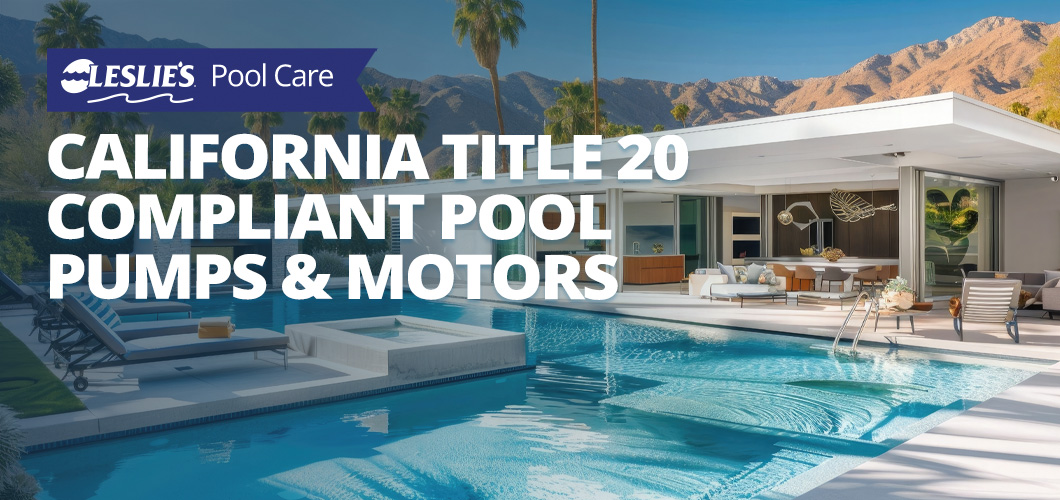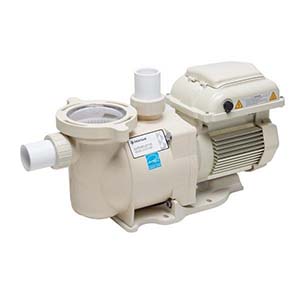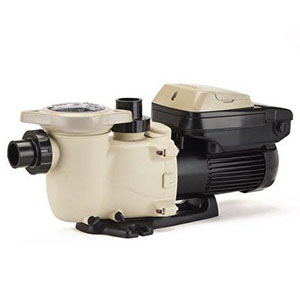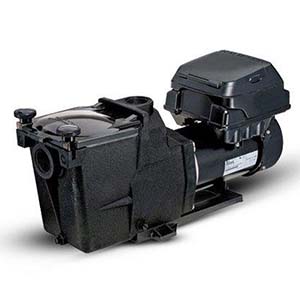
California Title 20 Compliant Pool Pumps & Motors
The Title 20 California Code of Regulations has governed pool pump purchases and installations in California since 2008. Though these laws are nothing new, as old pool pumps need to be replaced, many California residents may still be left wondering, “What pool pumps can I buy?” Here, we’ll answer some of the most common questions about California Title 20 and how it relates to pool pumps and pump motors.

What does Title 20 say about pool pumps?
Pool filtration pumps and replacement motors purchased and/or installed in California must follow the following basic guidelines:
- Single speed pumps must have a motor capacity less than 1 THP (total horsepower).
- Pool filter pumps with a motor capacity greater than 1 THP must operate at two or more speeds, such as a dual speed or variable speed pool pump. The low speed rotation rate cannot be more than half of the maximum rotation rate.
There is also specific verbiage regarding the motor’s start/run type, label requirements, pump control settings and limitations regarding the date a pump or motor was manufactured. These regulations apply to pool pumps for both inground and above ground residential pools.
Are there any single speed pumps NOT affected by these regulations?
The answer is YES. Although Title 20 regulations require single speed pool pumps to have a motor capacity less than 1 THP, these regulations do NOT include pumps that are exclusively used for water features (such as decorative fountains and waterfalls). Commercial pool pumps and booster pumps for pool cleaners are also not currently affected. Spa and hot tub pumps do not follow the same guidelines as residential pool pumps, but portable electric spas are still held to strict energy usage standards, which are also outlined in Title 20.
What is total horsepower?

Total horsepower looks at both the nameplate horsepower and the motor service factor of a pool pump. To calculate total horsepower (THP), simply multiply the horsepower (HP) by the motor’s service factor (SF).
HP x SF = THP
Even if the nameplate horsepower for a single speed pool pump is less than 1 HP, it may not meet Title 20 regulations. For example, let’s look at two different models of ¾ HP single speed pool pumps. Pump A has an SF of 1.4, while pump B has an SF of 1.3. Using the above equation, we’ll calculate the THP for both.
Pump A: 0.75 HP x 1.4 SF = 1.05 THP
Pump B: 0.75 HP x 1.3 SF = 0.975 THP
As you can see, even a slight variation in the motor’s service factor can make a huge difference in whether or not a pool pump motor is compliant with California Title 20 regulations. In this case, only pump B could be legally purchased and installed in the state of California. Otherwise, you'd need to purchase a dual speed or variable speed pool pump.
I have a pool pump that doesn’t meet the Title 20 requirements. Do I have to replace it?
The straightforward answer is YES. But as long as the pool pump is still working properly, you won’t need to get a new one right away. As soon as the pump fails or the motor needs replaced, you’ll have to find a more efficient pool pump to use with your filter system. However, as you’ll find out in the next section, the energy savings and available rebates may encourage you to replace your pump sooner than later.
Are there any incentives for replacing my non-compliant pool pump?

As a matter of fact, there are plenty! Variable speed pumps are the most efficient pool pumps on the market. It’s no secret that they demand the highest purchase price, but you’ll experience a significant return on your investment in no time at all. The energy savings alone can allow a variable speed pool pump to pay for itself in a couple of years, depending on the length of your pool season and the amount of hours the pump is running.
Beyond the annual usage savings, California utility companies also offer numerous pool pump rebates — some as much as $1,000. In addition, most pool equipment manufacturers provide hundreds of dollars in rebate incentives for purchasing dual speed or variable speed pumps. Before purchasing a new pool pump, make sure to read and follow all guidelines for the rebate(s) you’re trying to get.
Where can I find a California Title 20 compliant pool pump?
If you’re needing to replace your existing pool pump, or if you’re wanting to update your filter system with a more energy efficient pump, check out the large selection of California Title 20 compliant pool pumps and pump motors on the Leslie’s Pool Supplies website.
If you’d like to verify compliance for a specific pump model, you can also visit the California Appliance Efficiency Database.
Where can I find pool pump verbiage in Title 20?
To read the pool pump specifications from Title 20 California Code of Regulations, click the links below. Each link will bring you directly to the specified text within that section.
Title 20, Division 2, Chapter 4, Article 4: Appliance Efficiency Regulations
(Table of contents for applicable sections)
Section 1604(g)(3) – Test Methods for Specific Appliances
Section 1605.3(g)(5) – State Standards for Non-Federally-Regulated Appliances
Section 1606(a), Table X – Filing by Manufacturers; Listing of Appliances in Database
(Data Submittal Requirements)
Section 1606(a)(5)(g-h) – Filing by Manufacturers; Listing of Appliances in Database
(Marking of Appliances)
Section 1607(d)(9) – Marking of Appliances
What’s next for energy efficient pool systems?

California is recognized as one of the leading states when it comes to energy efficiency standards. Their policies are a guideline across many product categories – not just pool equipment. A few states have already adopted similar efficiency laws that mirror the requirements laid out in Title 20. However, a new federal standard from the Department of Energy (DOE) - Energy Conservation Standards for Dedicated-Purpose Pool Pumps - will supersede existing pump efficiency guidelines and may discontinue the sale of most single speed and dual speed pumps by 2021. Small, efficient pumps or variable speed pool pumps will soon become the norm for all pool owners.
With this new nationwide law looming on the horizon, pool owners across the country have already begun replacing their current pumps with variable speed models. Utility companies in many states already offer rebates for installing variable speed pumps. Even if you don't live in California, updating your pump to a more efficient model is a great way to keep your pool system compliant with the new federal regulations.


